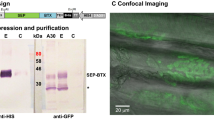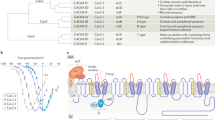Abstract
IT is well documented that calcium ions have an important role in the release of transmitter substances from nerve terminals1,2. There is, however, little information about the interactions of calcium with other chemical moieties within the nerve terminal which presumably are required to bring about transmitter release. Kosower and Werman3 postulated that calcium ions interact with two sulphydryl groups to form a calcium dithiolate complex. The formation of such a complex results in a decrease in the sulphur–sulphur distance which is presumed to produce a micro-contraction of the presynaptic membrane, thereby allowing for the quantal release of transmitter into the synaptic cleft. We show here that low concentrations of mercury ions (1 µM or less) increase the amount of transmitter released from motor nerve terminals. Since it is well known that mercury ions dissociating from inorganic mercury (HgCl2) form disulphide bridges in the presence of sulphydryl groups, we interpret our observations as being consistent with Kosower and Werman's hypothesis.
This is a preview of subscription content, access via your institution
Access options
Subscribe to this journal
Receive 51 print issues and online access
$199.00 per year
only $3.90 per issue
Buy this article
- Purchase on Springer Link
- Instant access to full article PDF
Prices may be subject to local taxes which are calculated during checkout
Similar content being viewed by others
References
Katz, B., The Release of Neural Transmitter Substances (Thomas, Springfield, Illinois, 1969).
Llinas, R., and Nicholson, C., Proc. natn. Acad. Sci. U.S.A., 72, 187–190 (1975).
Kosower, E. M., and Werman, R., Nature new Biol., 233, 121–122 (1971).
Werman, R., Carlen, P. L., Kosnir, M., and Kosower, E. M., Nature new Biol., 233, 120–121 (1971).
del Castillo, J., Escobar, I., and Gijon, E., Int. J. Neurosci., 1, 199–209 (1971).
del Castillo, J., Bartels, E., and Sobrino, J. A., Proc. natn. Acad. Sci. U.S.A., 69, 2081–2085 (1972).
Sobrino, J. A., and del Castillo, J., Int. J. Neurosci., 3, 251–258 (1972).
Peper, K., and McMahan, V. J., Proc. R. Soc. B 181, 431–440 (1972).
Miledi, R., J. Physiol., Lond., 151, 1–23 (1960).
Barrett, J. N., Botz, D., and Chang, D. B., in Behavioral Toxicology (edit. by Xintaras, C., Johnson, B. L., and de Groot, I.), 277–284, (Washington, U.S. Dept. of Health, Education, and Welfare, Washington DC, 1974).
Manalis, R. S., and Cooper, G. P., Nature, 243, 354–356 (1973).
Rustam, H., Von Burg, R., Amin-Zaki, L., and El Hassani, S., Archs Environ. Hlth, 30, 190–195 (1975).
Author information
Authors and Affiliations
Rights and permissions
About this article
Cite this article
MANALIS, R., COOPER, G. Evoked transmitter release increased by inorganic mercury at frog neuromuscular junction. Nature 257, 690–691 (1975). https://doi.org/10.1038/257690a0
Received:
Accepted:
Issue Date:
DOI: https://doi.org/10.1038/257690a0
This article is cited by
-
Effects of inorganic mercury (Hg2+) on calcium channel currents and catecholamine release from bovine chromaffin cells
Archives of Toxicology (1995)
-
GABA receptor-channel complex as a target site of Mercury, copper, zinc, and lanthanides
Cellular and Molecular Neurobiology (1994)
-
Inhibitory effects of HgCl2 on excitation-secretion coupling at the motor nerve terminal and excitation-contraction coupling in the muscle cell
Cellular and Molecular Neurobiology (1994)
-
Effect of HgCl2 on acetylcholine, carbachol, and glutamate currents ofAplysia neurons
Cellular and Molecular Neurobiology (1994)
-
Mercuric(II) chloride modulates single-channel properties of carbachol-activated Cl− channels in cultured neurons ofAplysia californica
Cellular and Molecular Neurobiology (1994)
Comments
By submitting a comment you agree to abide by our Terms and Community Guidelines. If you find something abusive or that does not comply with our terms or guidelines please flag it as inappropriate.



